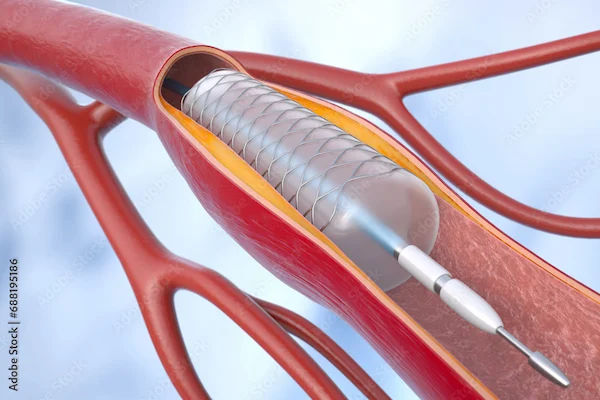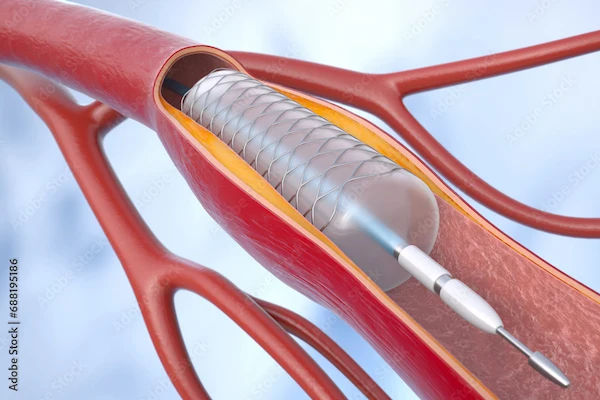Angioplasty: The Most Typical Treatment For Arteriosclerosis
Learn how angioplasty may help restore blood flow in patients with arteriosclerosis. Discover how the procedure works, potential risks, and tips for heart-healthy recovery.

Written by Dr.Sonia Bhatt
Last updated on 20th Jul, 2025

Introduction
Arteriosclerosis is a condition where your arteries—the blood vessels that carry oxygen-rich blood from your heart to the rest of your body—become thick and stiff. Over time, this can lead to blockages, reducing blood flow and increasing the risk of heart attacks and strokes. One of the most effective treatments for this condition is angioplasty, a minimally invasive procedure that helps restore normal blood flow.
If you or a loved one has been diagnosed with arteriosclerosis, understanding angioplasty can help ease concerns and prepare you for the treatment. This article explains what angioplasty is, how it works, and what to expect before, during, and after the procedure.
What Is Angioplasty?
Angioplasty is a medical procedure used to open narrowed or blocked arteries. It involves inserting a thin, flexible tube called a catheter into the affected artery. A tiny balloon at the tip of the catheter is inflated to widen the artery, and often, a small mesh tube called a stent is placed to keep the artery open.
This procedure is commonly used to treat:
Coronary artery disease (CAD) – Blockages in the heart’s arteries.
Peripheral artery disease (PAD) – Narrowing of arteries in the legs or arms.
Carotid artery disease – Blockages in the neck arteries that supply blood to the brain.
Why Is Angioplasty Needed?
Arteriosclerosis develops when fatty deposits (plaques) build up inside the arteries, making them narrow and rigid. This restricts blood flow, leading to:
Chest pain (angina) – Due to reduced blood supply to the heart.
Shortness of breath – Especially during physical activity.
Heart attack – If a plaque ruptures and completely blocks an artery.
Stroke – If a blockage occurs in the brain’s blood vessels.
Angioplasty helps restore blood flow, relieving symptoms and preventing serious complications.
What Happens During an Angioplasty?
A better understanding of the procedure may help ease anxiety and improve preparation.
1. Before the Procedure
Before the angioplasty begins, some preparations are usually required to ensure the procedure goes smoothly.
Your doctor will perform tests like an angiogram (an X-ray of the arteries) to locate blockages.
You may need to stop certain medications (like blood thinners) before the procedure.
Fasting for a few hours before the procedure is usually required.
2. During the Procedure
Angioplasty is performed in a specialised setting under local anaesthesia. Here’s a general idea of what takes place:
Local anaesthesia is given to numb the area where the catheter is inserted (usually the wrist or groin).
A thin guidewire is passed through the artery to the blockage.
A balloon-tipped catheter is guided to the narrowed area and inflated to widen the artery.
A stent (a small wire mesh tube) is often placed to keep the artery open.
The catheter is removed, and the small incision is closed with a bandage or stitches.
The procedure usually takes 30 minutes to 2 hours, and most patients stay in the hospital for 1-2 days for observation.
3. After the Procedure
Recovery typically begins right after the procedure. While most people can resume regular activities soon, care is still important.
You may feel some soreness at the insertion site.
Light activities can be resumed within a few days, but strenuous exercise should be avoided for about a week.
Medications (like blood thinners) may be prescribed to prevent clots.
Benefits and Risks of Angioplasty
Like any medical procedure, angioplasty may offer certain advantages and also carry possible risks. It’s best to discuss both with your doctor.
Benefits
Some benefits of angioplasty might include the following:
Minimally invasive option with no need for open surgery.
Faster recovery compared to surgical alternatives.
May help improve blood flow and reduce chest discomfort.
Might lower the chance of severe cardiovascular events in some individuals.
Possible Risks
Though generally considered safe, angioplasty may involve a few potential risks:
Bruising or bleeding where the catheter was inserted.
Rare cases of blood vessel injury.
Blood clot formation in or around the stent that may be reduced with medication.
Re-narrowing of the artery is more likely if a stent is not used.
Your doctor will discuss these risks and take precautions to minimise them.
Life After Angioplasty: How to Stay Healthy
Angioplasty is a highly effective treatment, but maintaining a heart-healthy lifestyle is crucial to prevent future blockages. Here are some tips:
1. Eat a Heart-Healthy Diet
What you eat after angioplasty may influence your long-term health outcomes.
Reduce saturated fats such as fried foods, red meat, and butter.
Increase fibre with foods like whole grains, fruits, and vegetables.
Choose lean proteins like fish, chicken, and beans.
Limit salt and sugar to control blood pressure and diabetes.
2. Exercise Regularly
Physical activity may help improve blood circulation and overall well-being.
Aim for 30 minutes of moderate exercise, such as walking or swimming, on most days.
Avoid heavy lifting and strenuous exercise for a few weeks after angioplasty.
3. Quit Smoking
Smoking damages blood vessels and increases the risk of new blockages.
4. Manage Stress
Chronic stress may negatively impact heart health, so stress management is essential. Practice relaxation techniques like deep breathing, yoga, or meditation.
5. Take Prescribed Medications
Adherence to medications may help prevent complications and support recovery.
Blood thinners (like aspirin) to prevent clots.
Cholesterol-lowering drugs (statins) to reduce plaque buildup.
Blood pressure medications if needed.
6. Regular Follow-Ups
Regular check-ins with your doctor may help detect problems early and allow for timely intervention.
When to Seek Medical Help
Even after a successful angioplasty, it's important to be aware of warning signs that may require urgent care. Call your doctor immediately if you experience:
Severe chest pain (could indicate a heart attack).
Swelling, bleeding, or infection at the catheter site.
Shortness of breath or dizziness after the procedure.
Book a consultation with Apollo24|7’s top cardiologists today and take the first step toward a healthier heart.
Conclusion
Angioplasty is a safe and effective treatment for arteriosclerosis, helping millions of people live healthier lives with improved blood flow. By combining this procedure with a heart-healthy lifestyle, you can reduce the risk of future heart problems and enjoy better overall health.
If you or someone you know is experiencing symptoms of blocked arteries, consult a cardiologist to discuss whether angioplasty is the right option.
Consult Top Cardiologists

Dr. Sumanta Chatterjee
Cardiologist
12 Years • MBBS,MD General Medicine,DM Cardiology
Kolkata
HealthYou Speciality Clinic & Diagnostics., Kolkata
(25+ Patients)

Dr. Amit. A. Bharadiya
Cardiologist
12 Years • MBBS, MD General Medicine, DNB Cardiology, FSCAI
Maharashtra
Surabhi Hospital, Maharashtra, Maharashtra
Dr. Dixit Garg
Cardiologist
10 Years • MBBS , DNB (General medicine) , DNB (cardiology)
Gurugram
Smiles & Hearts, Gurugram

Dr. Pinaki Nath
Cardiologist
8 Years • MBBS, MD General Medicine, DM Cardiology
Barasat
Diab-Eat-Ease, Barasat
Dr. Sibashankar Kar
Cardiologist
10 Years • MBBS, DNB
Bhubaneswar
Hi-Tech Medical College & Hospital, Bhubaneswar
Consult Top Cardiologists

Dr. Sumanta Chatterjee
Cardiologist
12 Years • MBBS,MD General Medicine,DM Cardiology
Kolkata
HealthYou Speciality Clinic & Diagnostics., Kolkata
(25+ Patients)

Dr. Amit. A. Bharadiya
Cardiologist
12 Years • MBBS, MD General Medicine, DNB Cardiology, FSCAI
Maharashtra
Surabhi Hospital, Maharashtra, Maharashtra
Dr. Dixit Garg
Cardiologist
10 Years • MBBS , DNB (General medicine) , DNB (cardiology)
Gurugram
Smiles & Hearts, Gurugram

Dr. Pinaki Nath
Cardiologist
8 Years • MBBS, MD General Medicine, DM Cardiology
Barasat
Diab-Eat-Ease, Barasat
Dr. Sibashankar Kar
Cardiologist
10 Years • MBBS, DNB
Bhubaneswar
Hi-Tech Medical College & Hospital, Bhubaneswar




